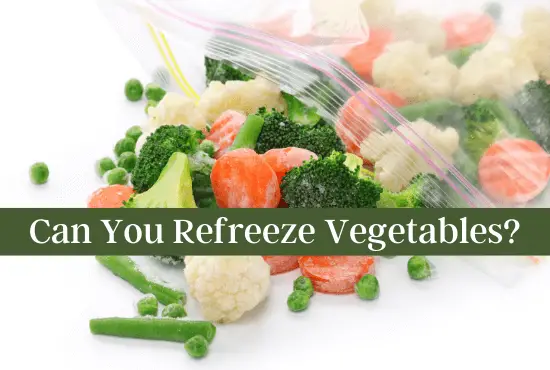Not all vegetables are available to you every passing season. Hence, freezing them is a great way to enjoy your favorite picks throughout the year.
But, sometimes, a mishap might cause the vegetables to spoil earlier. If you don’t want to let them go to waste, you might wonder, can you refreeze vegetables?
Vegetables thawed in a refrigerator that are not showing any signs of spoilage can refreeze for up to a year. However, refreezing them more than once is not recommended. You can flash-freeze them and divide the vegetables into portions before refreezing. It will enable you to avoid repeated thawing and freezing.
Vegetables will hold on to many essential nutrients if you store them properly. This detailed guide is here to help you learn about handling your veggies while refreezing them.
Table of Contents
Is it safe to refreeze vegetables?
Refreezing vegetables comes in super handy if you want to increase their shelf-life and store them in the long run.
Refreezing vegetables is entirely safe. However, not all vegetables fit this criterion, and when it comes to refreezing them, there are a few vegetables that you should never refreeze for the sake of quality.
You should avoid refreezing vegetables that have thawed at room temperature, in a microwave, or under cold water. They will get exposed to air for too long if you defrost them using any of these methods.
Extended exposure to air is harmful to all foods and vegetables, as it causes the food to go rancid. It will also amp up the speed of bacterial formation and lead to contamination.
Another vital thing to remember is that you should avoid refreezing the vegetables that have been sitting outside the fridge for more than 2 hours. If the ice crystals are still present on their surface, you can pop them back into the freezer.
How to refreeze vegetables?
Vegetables will stay in a relatively good state if you handle them properly before refreezing. You can follow the instructions mentioned below to ensure the safe refreezing of your vegetables.
- Take the adequately thawed vegetables out of the refrigerator.
- Next, cook them according to your preference and add spices of your choice.
- After that, place the vegetables on a freezer-safe tray and let them freeze overnight or until the vegetables have frozen solid.
- When the vegetables have frozen thoroughly, take the tray out of the freezer and place it on the counter.
- Start dividing the frozen vegetables into meal-size portions or portions according to your preference. Refreezing in small batches will grant you more control over how many vegetables you want to take out at a time. It will also save the unneeded portion from defrosting.
- When you are happy with the size of the portions, start placing the veggies inside a freezer-safe bag/Ziploc bag. Before sealing the bag close, make sure to squeeze out as much air as possible.
- Label these bags with the refreezing date and place them in a cold corner in the freezer.
What vegetables are and aren’t safe for refreezing?
Before you go ahead and pop every thawed vegetable back into the freezer, it’s better to know what vegetables are safe for refreezing. So, here we will discuss some vegetables that can and can’t be refrozen.
Vegetables that are safe for refreezing
Vegetables that won’t show a significant decline in quality, taste, and texture are considered safe for refreezing. These vegetables might even last you for up to a year if you seal them properly and take care of the temperature in the freezer.
Corn, Peas, Carrots, Spinach, Broccoli, Potatoes, Kale, etc., are considered safe for refreezing, as they retain the overall quality in a better way.
However, sometimes even these vegetables might not be safe for refreezing and should be discarded immediately. If you notice a considerable decline in quality or loss of color, it’s better to throw the vegetables away.
Vegetables that aren’t safe for refreezing
Avoid refreezing vegetables such as celery, parsley, cucumber, asparagus, lettuce, tomatoes, etc. The second round of refreezing and thaw might make the vegetables taste and look unpleasant.
For such vegetables, it’s better to freeze them in portions so that you may only take out the needed amount. It will enable you to save the rest from unnecessary thawing. Moreover, such vegetables will lose a lot of moisture, and the cell walls might rupture due to refreezing, which will make the taste awful.
Things to Consider While Refreezing Vegetables
To get the most out of refreezing, you need to follow the refreezing instructions properly. But besides them, there are also a few other factors that affect how well the vegetables refreeze.
Ice Crystals
If you plan to freeze any vegetables, you will encounter the formation of ice crystals. These ice crystals indicate taste and texture degradation. Besides the overall quality loss, they won’t make the vegetable unsafe for consumption.
You can still safely eat it, but it will compromise the flavor and texture.
Temperature
Before refreezing vegetables, make sure to check your freezer’s temperature to ensure the veggies refreeze properly. It’s best to refreeze the vegetables at 0 F (-18 C). If your freezer is at a very high/low temperature, the food will undergo degradation.
A stable temperature will also ensure the vegetables stay in the best condition.
Bacteria
If you spot bacterial formation (fungus or any mold), it means that the vegetable has spoiled. If this is the case, it is best to discard the vegetables instantly. Refreezing won’t kill the bacteria; it will only slow down their spread. They tend to become active as soon as you thaw the vegetable.
Quality
Refreezing will also lower the overall quality of the vegetables. The water present in the cells of food expands on freezing. When you thaw and refreeze food, the cells rupture due to contraction and expansion.
It will lead to leakage from vegetables. If you witness any such condition, it’s best to get rid of it.
How Long Can You Refreeze Vegetables?
Most properly refrozen vegetables will last you for up to a year. If you avoid refreezing them repeatedly, you can enjoy the healthy benefits. However, you might notice a subtle difference in the taste and texture.
After the 1-year limit crosses, it is not ideal to still store the vegetables. After this period, eating them can be dangerous for your health, so it’s better to discard them.
Can you refreeze Vegetables more than Once?
You should avoid refreezing vegetables more than once. As we mentioned earlier, the vegetables become bland and soggy after repeated refreezing. Moreover, the cell structure starts degrading, causing the vegetables to release liquids. After such a disaster, it’s not wise to eat them.
If you feel like you might need to refreeze the vegetables again, you can instead refreeze them in portions. It will enable you only to take out the required amount and save the rest from defrosting.
Conclusion
Vegetables are safe for refreezing as long as you handle them properly before refreezing. However, this statement doesn’t apply to all the vegetables. There are a few vegetables that are safe for refreezing. In contrast, others are best when eaten fresh or cooked immediately after the first thaw.
While refrozen vegetables won’t taste as good as fresh ones, they are safe for consumption. You can refreeze the vegetables for up to a year and enjoy optimum quality.
However, if you want the vegetables to stay in the best shape, you should avoid refreezing them more than once.
Recommended Readings:


